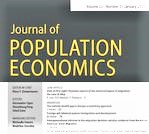A new paper published in the Journal of Population Economics indicates that the decrease in public sector employment, which is particularly appealing to women, may have contributed to the recent rise in fertility in Egypt.
Read more in:
Why is fertility on the rise in Egypt? The role of women’s employment opportunities
Caroline Krafft
Journal of Population Economics (2020) 33, Issue 4: 1173-1218
FREE READLINK
GLO Fellow Caroline Krafft

Author Abstract: Can declining employment opportunities for women reverse the fertility transition? This paper presents evidence that the demographic transition has not just stalled but in fact reversed in Egypt. After falling for decades, fertility rates increased. The paper examines the drivers of rising fertility rates, with a particular focus on the role of declining public sector employment opportunities for women. Estimates show the effect of public sector employment on the spacing and occurrence of births using discrete-time hazard models. The paper then uses the results to simulate total fertility rates. The models address the potential endogeneity of employment by incorporating woman-specific fixed effects, incorporating local employment opportunities rather than women’s own employment, and using local employment opportunities as an instrument. Results indicate that the decrease in public sector employment, which is particularly appealing to women, may have contributed to the rise in fertility but is unlikely to be its main cause.
Access to the newly published complete Volume 33, Issue 4, October 2020.
LEAD ARTICLE OF ISSUE 4:
Yun Qiu, Xi Chen & Wei Shi, Impacts of social and economic factors on the transmission of coronavirus disease 2019 (COVID-19) in China
Journal of Population Economics 33, 1127–1172 (2020). OPEN ACCESS

Ends;
